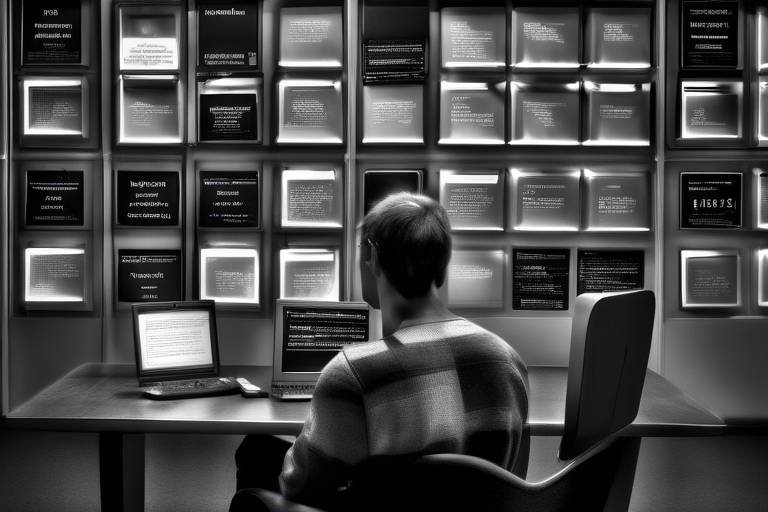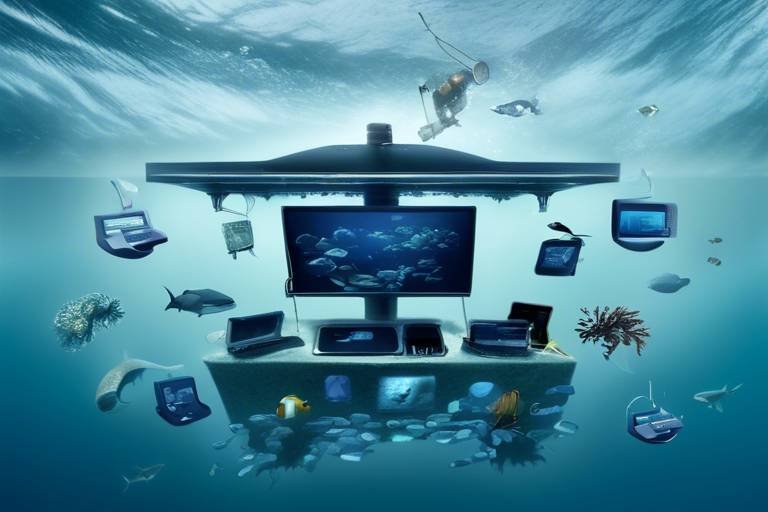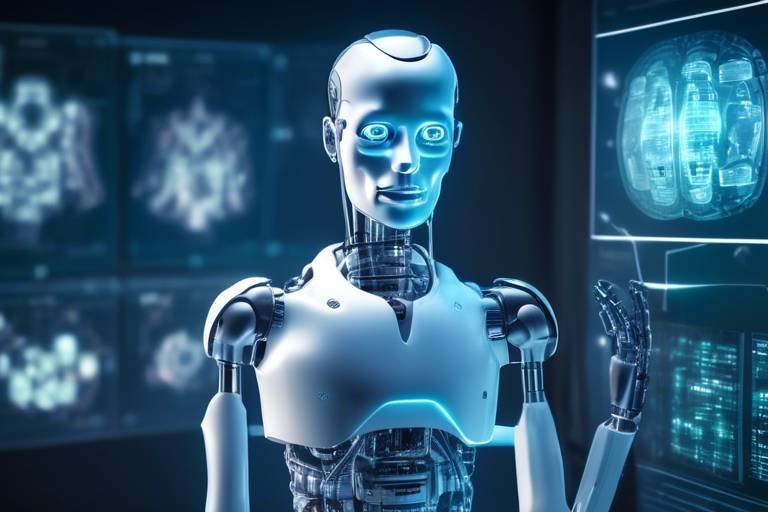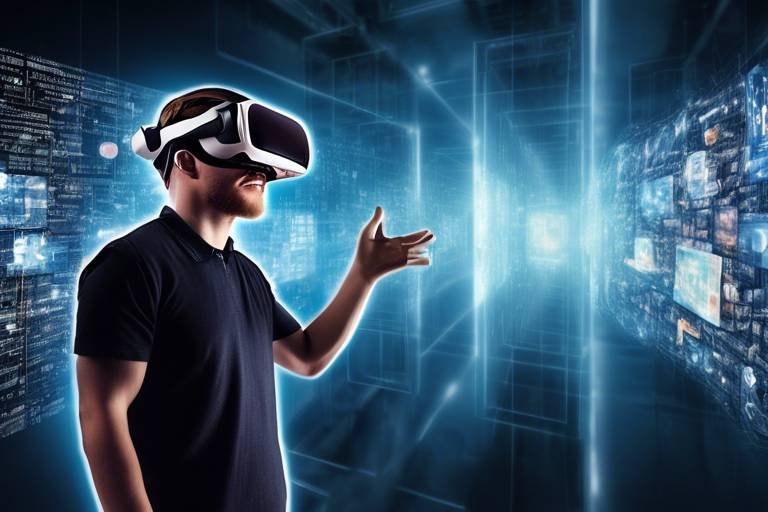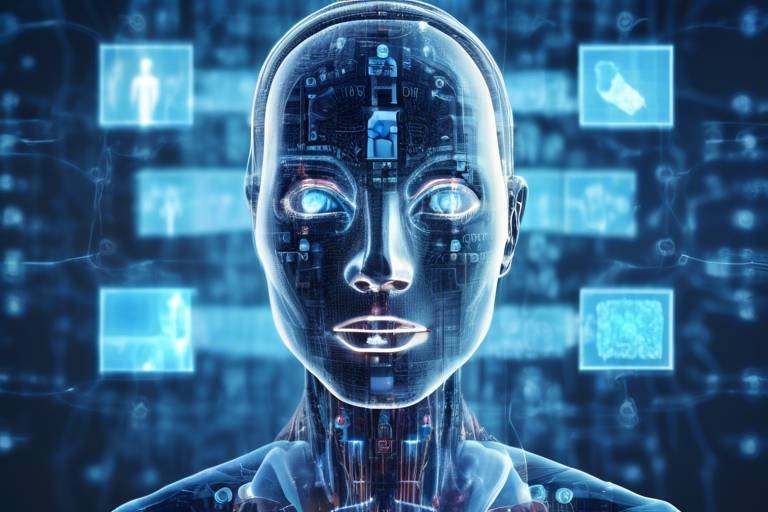How Digital Twins are Changing Scientific Modeling
In today's fast-paced technological landscape, the concept of digital twins has emerged as a game-changer, particularly in the realm of scientific modeling. Imagine having a virtual counterpart of a physical entity—be it a patient, a machine, or even an entire city. This is precisely what digital twins offer: a dynamic, real-time representation that allows for unparalleled analysis and optimization. By integrating data from various sources, digital twins not only reflect the current state of their physical counterparts but also predict future behaviors and outcomes. This transformative capability is reshaping how scientists, engineers, and healthcare professionals approach their work, leading to more informed decisions and innovative solutions.
The beauty of digital twins lies in their ability to bridge the gap between the physical and digital worlds. They provide a platform where real-time data can be analyzed, enabling users to simulate different scenarios without the risks associated with real-world experimentation. For instance, in healthcare, a digital twin of a patient can simulate how they might respond to a specific treatment. This means doctors can tailor their approaches based on accurate predictions rather than relying solely on generalized data. It's like having a crystal ball that offers insights into the future, helping professionals make decisions that are not only informed but also optimized for individual circumstances.
Moreover, the implications of digital twins extend far beyond healthcare. In engineering, they allow for the testing of designs and systems in a virtual environment before any physical implementation takes place. This not only minimizes risks but also significantly reduces costs associated with trial and error in the real world. Imagine being able to tweak a design in a virtual space until it's perfect, eliminating costly mistakes before they even happen. It’s a bit like being an architect who can walk through a building before it’s constructed, making changes on the fly.
Digital twins are also making waves in environmental science, where they simulate ecosystems and climate change scenarios. This modeling is crucial for understanding complex interactions within our environment and helps inform sustainable practices. For instance, city planners can utilize digital twins to visualize and analyze urban dynamics, leading to smarter infrastructure development that enhances community resilience against environmental challenges. It’s a proactive approach that not only addresses current issues but also anticipates future needs.
In summary, as we continue to explore the vast potential of digital twins, it becomes clear that they are not just a technological trend but a fundamental shift in how we approach scientific modeling. By harnessing the power of real-time data and predictive analytics, digital twins are paving the way for innovations across various fields, ultimately enhancing our ability to make informed decisions that can lead to better outcomes for individuals, organizations, and the environment as a whole.
- What are digital twins? Digital twins are virtual replicas of physical entities that allow for real-time monitoring and simulation.
- How do digital twins benefit healthcare? They enable personalized medicine by simulating patient responses to treatments, enhancing clinical decision-making.
- Can digital twins be used in engineering? Yes, they revolutionize design and maintenance processes by allowing engineers to test and optimize systems virtually.
- What role do digital twins play in environmental science? They help simulate ecosystems and climate change scenarios, aiding in sustainable practices and urban planning.

The Concept of Digital Twins
This article explores the transformative impact of digital twins on scientific modeling, highlighting their applications, benefits, and future potential in various fields such as healthcare, engineering, and environmental science.
Digital twins are more than just a buzzword; they represent a groundbreaking leap in how we understand and interact with the physical world. Imagine having a virtual replica of a real-world object, system, or process that allows you to monitor, analyze, and predict its behavior in real-time. This virtual counterpart is not static; it evolves as the physical entity changes, providing a dynamic platform for simulation and optimization.
At their core, digital twins integrate data from various sources, including sensors, historical records, and real-time inputs, to create a comprehensive model. This model can be anything from a simple machine to a complex ecosystem. The implications are vast, as digital twins can be used across numerous industries, including healthcare, engineering, and environmental science.
To fully appreciate the role of digital twins in enhancing scientific modeling and decision-making processes, it's essential to understand their key components:
- Data Integration: Digital twins pull data from multiple sources, creating a holistic view of the physical entity.
- Real-time Monitoring: They allow for continuous observation, enabling timely interventions when necessary.
- Predictive Analytics: By analyzing trends and patterns, digital twins can forecast future states and behaviors.
Ultimately, digital twins serve as a bridge between the physical and digital worlds, enabling scientists and engineers to conduct experiments and simulations that would be impractical or impossible in reality. This capability not only enhances our understanding but also drives innovation by allowing for rapid prototyping and testing.
In healthcare, digital twins facilitate personalized medicine by simulating patient responses to treatments. This application enhances clinical decision-making and improves patient outcomes through tailored therapeutic strategies.
Digital twins employ predictive analytics to forecast disease progression and treatment efficacy. This capability allows healthcare providers to intervene proactively, optimizing patient care and resource allocation.
Through real-time monitoring, digital twins enable continuous assessment of patient health metrics, ensuring timely interventions and minimizing adverse outcomes. This dynamic approach enhances patient safety and quality of care.
Digital twins streamline clinical trials by simulating patient populations, thereby improving trial design and reducing time and costs associated with bringing new therapies to market.
In engineering, digital twins are revolutionizing design and maintenance processes. By creating accurate virtual models, engineers can test and optimize systems before physical implementation, reducing risks and costs.
Digital twins play a significant role in environmental science by simulating ecosystems and climate change scenarios. This modeling aids in understanding complex interactions and informing sustainable practices.
In urban planning, digital twins help visualize and analyze city dynamics. This technology supports smarter infrastructure development and enhances community resilience against environmental challenges.
Digital twins enable efficient resource management by simulating usage patterns and predicting future needs. This application promotes sustainability and helps organizations optimize their operational efficiency.
What is a digital twin?
A digital twin is a virtual representation of a physical object or system that is updated in real-time using data from sensors and other sources. It allows for monitoring, simulation, and optimization.
How are digital twins used in healthcare?
In healthcare, digital twins are used to simulate patient responses to treatments, predict disease progression, and optimize clinical trials, ultimately enhancing patient outcomes.
What industries benefit from digital twins?
Digital twins are beneficial in various industries, including healthcare, engineering, manufacturing, and environmental science, enabling improved decision-making and innovation.
Can digital twins help with urban planning?
Yes, digital twins can visualize and analyze urban dynamics, supporting smarter infrastructure development and enhancing community resilience against environmental challenges.

Applications in Healthcare
This article explores the transformative impact of digital twins on scientific modeling, highlighting their applications, benefits, and future potential in various fields such as healthcare, engineering, and environmental science.
Digital twins represent a virtual replica of physical entities, allowing real-time monitoring and simulation. Understanding this concept is crucial for appreciating their role in enhancing scientific modeling and decision-making processes.
In the realm of healthcare, digital twins are proving to be game-changers, facilitating a shift towards more personalized medicine. Imagine having a virtual version of yourself that can predict how your body will respond to various treatments. This is precisely what digital twins offer. By simulating patient responses based on real-time data, healthcare professionals can tailor therapeutic strategies to fit individual needs. This not only enhances clinical decision-making but also significantly improves patient outcomes.
One of the most exciting aspects of digital twins in healthcare is their ability to employ predictive analytics. This technology allows healthcare providers to forecast disease progression and evaluate the efficacy of treatments before they are administered. For instance, if a doctor is considering a new medication for a patient with a chronic condition, a digital twin can simulate how that patient might respond based on their unique health metrics. This proactive approach enables timely interventions, optimizing patient care while also ensuring that resources are allocated efficiently.
With predictive analytics, the potential to revolutionize patient care is immense. By analyzing vast amounts of data, digital twins can identify trends and patterns that may not be immediately obvious. This capability allows healthcare providers to anticipate complications and adjust treatment plans accordingly. For example, consider a patient undergoing chemotherapy. A digital twin can simulate how the patient's body might react over time, helping doctors to modify the treatment plan to minimize side effects and maximize effectiveness.
Moreover, through real-time monitoring, digital twins enable continuous assessment of patient health metrics. This means that healthcare providers can keep a close eye on vital signs and other important indicators, ensuring that any changes are promptly addressed. Imagine a scenario where a patient’s heart rate suddenly spikes. With a digital twin in place, medical staff can receive immediate alerts, allowing for timely interventions that could save lives. This dynamic approach significantly enhances patient safety and overall quality of care.
Digital twins also play a crucial role in optimizing clinical trials. By simulating diverse patient populations, researchers can design trials that are more efficient and effective. This not only reduces the time it takes to bring new therapies to market but also cuts down on the costs associated with traditional trial methods. For instance, instead of recruiting hundreds of participants for a trial, researchers can use digital twins to model potential outcomes based on a smaller, more manageable group. This innovative approach is paving the way for faster and more reliable drug development.
In summary, the applications of digital twins in healthcare are vast and varied. They are not just a technological novelty; they are reshaping how we approach medicine. From personalized treatment plans to enhanced safety protocols, the future of healthcare is undeniably brighter with the integration of digital twin technology.
- What are digital twins? Digital twins are virtual replicas of physical entities that allow for real-time monitoring and simulation.
- How do digital twins improve healthcare? They enable personalized medicine, predictive analytics, real-time monitoring, and optimization of clinical trials.
- Can digital twins predict disease progression? Yes, they can analyze data to forecast how diseases may progress in individual patients.
- Are digital twins used in other fields? Absolutely! They are also applied in engineering, environmental science, and urban planning.

Predictive Analytics
Predictive analytics is a game-changer in the realm of healthcare, particularly when it comes to leveraging the power of digital twins. Imagine having a crystal ball that not only sees the future but also provides actionable insights based on real-time data. This is precisely what predictive analytics offers. By utilizing complex algorithms and machine learning techniques, healthcare providers can forecast disease progression and treatment outcomes with remarkable accuracy. This capability is like having a personal guide through the often unpredictable journey of patient care.
At its core, predictive analytics employs vast amounts of data collected from various sources, including electronic health records, genetic information, and even lifestyle factors. By analyzing this data, healthcare professionals can identify patterns and trends that may not be immediately obvious. For instance, if a patient has a specific genetic marker, predictive analytics can help determine the likelihood of developing certain conditions, allowing for early intervention and tailored treatment plans. This proactive approach not only enhances the quality of care but also empowers patients to take charge of their health.
One of the most exciting aspects of predictive analytics in digital twins is the ability to simulate different treatment scenarios. Think of it as a sophisticated 'what if' game where doctors can test various treatment paths without putting the patient at risk. By running simulations, healthcare providers can evaluate the potential effectiveness of different therapies, optimizing treatment plans based on individual responses. This personalized approach is akin to customizing a suit; it ensures that the treatment fits the patient perfectly, rather than adopting a one-size-fits-all model.
Furthermore, predictive analytics can significantly improve resource allocation within healthcare systems. By anticipating patient needs and potential surges in demand, hospitals can better manage their resources, ensuring that staff and facilities are prepared for what lies ahead. This not only enhances operational efficiency but also contributes to better patient outcomes, as timely interventions can be made based on predictive insights.
To illustrate the impact of predictive analytics, consider the following table that summarizes key benefits:
| Benefit | Description |
|---|---|
| Early Intervention | Identifying potential health issues before they become critical. |
| Personalized Treatment Plans | Customizing therapies based on individual patient data and simulations. |
| Resource Optimization | Improving hospital resource management through accurate demand forecasting. |
| Enhanced Patient Engagement | Empowering patients with knowledge about their health and treatment options. |
In conclusion, predictive analytics is not just a buzzword; it represents a fundamental shift in how healthcare providers approach patient care. By harnessing the power of digital twins, predictive analytics transforms data into meaningful insights, ultimately leading to improved health outcomes. The future of healthcare is bright, and with predictive analytics at the forefront, we can look forward to a more personalized, efficient, and proactive approach to medicine.
- What are digital twins? Digital twins are virtual replicas of physical entities that allow for real-time monitoring and simulation.
- How does predictive analytics improve healthcare? It helps forecast disease progression and treatment efficacy, enabling proactive interventions.
- Can predictive analytics personalize treatment plans? Yes, it allows healthcare providers to customize therapies based on individual patient data.
- What role do digital twins play in resource management? They simulate usage patterns to predict future needs, promoting sustainability and efficiency.

Real-time Monitoring
Imagine having a personal health assistant that constantly tracks your well-being, alerting you to potential issues before they escalate. through digital twins makes this a reality in healthcare. By creating a virtual replica of a patient, healthcare providers can continuously assess vital health metrics such as heart rate, blood pressure, and oxygen levels. This dynamic approach not only enhances patient safety but also significantly improves the quality of care.
When we think about traditional healthcare, it often resembles a game of catch-up—doctors react to symptoms after they arise rather than preventing them in the first place. However, with digital twins, the narrative shifts dramatically. Continuous data collection and analysis allow clinicians to identify trends and anomalies in a patient's health. For instance, if a patient's heart rate spikes unexpectedly, the digital twin can instantly notify the healthcare team, enabling them to intervene swiftly. This proactive strategy can be a game-changer, especially for patients with chronic conditions.
Furthermore, the integration of real-time monitoring with advanced analytics can lead to more personalized treatment plans. By understanding how a patient responds to various interventions in real-time, healthcare providers can adjust medications and therapies to optimize outcomes. This level of customization is akin to having a tailored suit—everything fits perfectly to the individual's needs, ensuring comfort and effectiveness.
To illustrate the impact of real-time monitoring, consider the following table that highlights key benefits:
| Benefit | Description |
|---|---|
| Timely Interventions | Immediate alerts enable healthcare providers to act swiftly, reducing the risk of complications. |
| Data-Driven Decisions | Real-time data empowers clinicians to make informed decisions tailored to individual patient needs. |
| Enhanced Patient Engagement | Patients are more involved in their care, leading to better adherence to treatment plans. |
In conclusion, the power of real-time monitoring through digital twins is transforming how we approach patient care. It shifts the focus from reactive treatment to proactive health management, creating a safer and more efficient healthcare environment. As technology continues to evolve, we can only imagine the possibilities this innovative approach will unlock for patients and healthcare providers alike.
- What is a digital twin? A digital twin is a virtual representation of a physical entity, allowing for real-time monitoring and simulation.
- How does real-time monitoring improve patient care? It enables timely interventions and personalized treatment plans based on continuous health data.
- What are the applications of digital twins in healthcare? Applications include personalized medicine, predictive analytics, and clinical trial optimization.

Clinical Trials Optimization
In the fast-paced world of healthcare, the pressure to bring new therapies to market efficiently and effectively is immense. This is where digital twins come into play, acting as a game-changing tool in the optimization of clinical trials. By simulating patient populations, digital twins allow researchers to explore various scenarios without the need for extensive real-world testing. Imagine having a virtual environment where you can test the efficacy of a drug on a diverse group of patients, adjusting variables like age, genetic background, and existing health conditions—all without the ethical concerns or logistical challenges of traditional trials.
One of the most significant benefits of using digital twins in clinical trials is the ability to reduce time and costs. Traditional clinical trials can take years and involve substantial financial investments. With digital twins, researchers can identify potential issues early in the process, allowing for quicker adjustments and refinements. This not only accelerates the timeline but also minimizes the risk of failure in later stages of the trial. For instance, a recent study indicated that using digital twin technology could cut the average time to market for new drugs by up to 30%.
Moreover, digital twins enhance the precision of trial design. By utilizing vast amounts of data from previous trials and real-world evidence, researchers can create more accurate and representative models of patient populations. This means that the trials can be tailored to reflect the complexities of real-life scenarios, ultimately leading to more reliable and applicable results. The ability to simulate different outcomes based on various treatment strategies provides invaluable insights that can guide clinical decision-making.
Another crucial aspect of clinical trials optimization is the ability to monitor patient responses in real-time. Digital twins can continuously assess how patients are reacting to treatments, allowing for immediate adjustments if necessary. This dynamic feedback loop is vital for ensuring patient safety and maximizing therapeutic efficacy. By integrating real-time data, researchers can pivot their strategies based on actual patient responses rather than relying solely on pre-set hypotheses.
In summary, the integration of digital twins into clinical trials represents a paradigm shift in how new therapies are developed and tested. By leveraging advanced simulations, researchers can enhance efficiency, reduce costs, and improve the safety and effectiveness of clinical trials. As this technology continues to evolve, we can expect even more innovative approaches to emerge, ultimately leading to better patient outcomes and a more robust healthcare system.
- What are digital twins? Digital twins are virtual replicas of physical entities, allowing real-time monitoring and simulation to enhance decision-making processes.
- How do digital twins improve clinical trials? They optimize trial design by simulating patient populations, reducing time and costs, and allowing for real-time monitoring of patient responses.
- Can digital twins be used in other fields? Yes, digital twins have applications in various fields, including healthcare, engineering, and environmental science.
- What is the future potential of digital twins? The future potential includes more precise modeling, enhanced predictive analytics, and broader applications across industries, leading to innovative solutions and improved outcomes.

Engineering Innovations
In the realm of engineering, digital twins are not just a passing trend; they are a revolutionary force reshaping how we approach design, maintenance, and innovation. Imagine being able to create a highly detailed virtual model of a bridge, a building, or even an entire manufacturing plant. This is exactly what digital twins allow engineers to do. By simulating real-world conditions and behaviors, engineers can test their designs in a virtual environment before any physical construction begins. This not only saves time but also significantly reduces the risk of costly errors that could arise during the actual build.
One of the most compelling aspects of digital twins in engineering is their ability to facilitate predictive maintenance. Instead of waiting for a machine to break down or a structure to show signs of wear, engineers can monitor the digital twin in real-time to identify potential issues before they escalate. This proactive approach leads to enhanced operational efficiency and extends the lifespan of critical assets. For example, consider a manufacturing facility equipped with sensors that feed data into a digital twin. Engineers can analyze this data to predict when a machine might fail, allowing them to schedule maintenance at the most convenient time, thereby minimizing downtime.
Moreover, digital twins enable engineers to conduct what-if analyses. This means they can simulate various scenarios—like changes in load, environmental conditions, or even the impact of a natural disaster—on their designs. By understanding how a structure or system will behave under different circumstances, engineers can make informed decisions that enhance safety and performance. For instance, if a city is planning to build a new bridge, engineers can use a digital twin to assess how it will withstand extreme weather events, ensuring it meets safety standards and community needs.
To illustrate the impact of digital twins on engineering innovations, consider the following table that highlights key benefits:
| Benefit | Description |
|---|---|
| Cost Reduction | Minimizes the need for physical prototypes and reduces errors during construction. |
| Enhanced Collaboration | Facilitates communication among teams by providing a shared virtual model. |
| Informed Decision-Making | Allows for data-driven decisions based on real-time insights and simulations. |
| Improved Safety | Identifies potential failures and hazards before they become critical issues. |
As the engineering landscape continues to evolve, the integration of digital twins is paving the way for smarter, more efficient practices. With the ability to visualize complex systems and predict outcomes, engineers are empowered to innovate like never before. They can explore new materials, optimize designs, and even collaborate with other industries to create solutions that benefit society as a whole. The future of engineering is undoubtedly bright, fueled by the transformative power of digital twins.
- What are digital twins? Digital twins are virtual replicas of physical entities that allow for real-time monitoring and simulation.
- How do digital twins benefit engineering? They enable predictive maintenance, cost reduction, enhanced collaboration, and informed decision-making.
- Can digital twins be used in other fields? Yes, they are widely used in healthcare, environmental science, and urban planning, among others.
- What is predictive maintenance? Predictive maintenance involves using data from digital twins to anticipate and address potential failures before they occur.

Environmental Impact Modeling
In today's world, where environmental challenges are becoming increasingly complex, digital twins are emerging as powerful tools for modeling environmental impacts. These virtual replicas of physical systems enable scientists and researchers to simulate various scenarios, analyze data, and predict outcomes in real-time. Imagine having a detailed, dynamic model of an ecosystem that can mimic changes in climate, pollution, or human activity—this is the essence of environmental impact modeling using digital twins.
One of the most fascinating applications of digital twins in environmental science is their ability to simulate ecosystems. By creating a digital twin of a forest, for instance, researchers can observe how factors such as temperature changes, rainfall variability, and human interference affect biodiversity and ecosystem health. This approach not only aids in understanding the delicate balance of nature but also helps in developing strategies to mitigate negative impacts. The ability to visualize these interactions is akin to having a crystal ball that reveals the potential future of our planet.
Furthermore, digital twins are instrumental in climate change modeling. They allow scientists to project future climate scenarios by incorporating vast amounts of data, including greenhouse gas emissions, land use changes, and population growth. By running simulations, researchers can assess the potential impacts of different policy decisions or technological advancements on climate outcomes. For example, a digital twin of a coastal city can help planners understand how rising sea levels might affect infrastructure and public safety, guiding them in making informed decisions to protect their communities.
Another significant area where digital twins shine is in urban planning. Cities are complex systems that require careful consideration when it comes to development and sustainability. By leveraging digital twins, urban planners can visualize city dynamics and assess the impact of new projects before they are built. This technology supports smarter infrastructure development by enabling planners to analyze factors such as traffic flow, energy consumption, and environmental impacts. The result? More resilient cities that can adapt to environmental challenges.
To illustrate the benefits of digital twins in environmental impact modeling, consider the following table that highlights key applications and their advantages:
| Application | Advantages |
|---|---|
| Climate Change Modeling | Predicts future climate scenarios, informs policy decisions, and enhances understanding of climate dynamics. |
| Ecosystem Simulation | Aids in biodiversity conservation, assesses impacts of human activity, and supports sustainable practices. |
| Urban Planning | Visualizes city dynamics, optimizes infrastructure development, and enhances community resilience. |
| Resource Management | Improves efficiency, predicts future resource needs, and promotes sustainability. |
In conclusion, as we face pressing environmental issues, the role of digital twins in environmental impact modeling cannot be overstated. They provide a unique lens through which we can view and understand the complexities of our ecosystems and urban environments. By harnessing the power of these virtual replicas, we can make informed decisions that not only benefit our immediate surroundings but also contribute to a sustainable future for generations to come.
- What is a digital twin? A digital twin is a virtual model of a physical object or system that allows for real-time monitoring and simulation.
- How are digital twins used in environmental science? They are used to simulate ecosystems, model climate change impacts, and optimize urban planning and resource management.
- What are the benefits of using digital twins? Digital twins provide insights into complex systems, enhance decision-making, improve efficiency, and promote sustainability.
- Can digital twins predict future environmental conditions? Yes, by incorporating various data sources, digital twins can forecast future scenarios and outcomes.

Urban Planning
Urban planning is undergoing a remarkable transformation thanks to the advent of digital twins. Imagine a city where every building, street, and park is not just a physical entity but also a dynamic digital replica. This is what digital twins bring to the table—a powerful tool that enables city planners to visualize and analyze urban dynamics in real-time. By creating a virtual environment that mirrors the actual city, planners can simulate various scenarios, from traffic flow to emergency responses, thereby making informed decisions that enhance the quality of life for residents.
One of the most compelling aspects of digital twins in urban planning is their ability to support smarter infrastructure development. With the help of advanced analytics, planners can assess the impact of new projects before they even break ground. For example, if a new subway line is proposed, a digital twin can model how it will affect traffic patterns, air quality, and even social interactions within the community. This predictive capability allows for adjustments to be made early in the design process, saving time and resources while ensuring that the infrastructure meets the needs of the population.
Moreover, digital twins foster community resilience against environmental challenges. As cities face the growing threats of climate change, urban planners can use these digital models to simulate the effects of extreme weather events, such as flooding or heat waves. By understanding how these scenarios could impact various neighborhoods, planners can develop adaptive strategies that enhance the city’s resilience. For instance, they can identify which areas are most vulnerable and prioritize investments in green infrastructure, such as parks and permeable surfaces, to mitigate potential damage.
To illustrate the impact of digital twins on urban planning, consider the following table that outlines key benefits:
| Benefit | Description |
|---|---|
| Enhanced Decision-Making | Data-driven insights allow planners to make informed choices based on real-time simulations. |
| Cost Efficiency | Identifying potential issues early in the planning process reduces overall project costs. |
| Community Engagement | Digital twins provide a platform for public participation, allowing citizens to visualize and contribute to planning efforts. |
| Sustainability | Simulations of resource usage help in developing sustainable practices within urban environments. |
In conclusion, the integration of digital twins into urban planning not only enhances the efficiency of the planning process but also strengthens the relationship between city planners and the communities they serve. By leveraging real-time data and simulations, urban planners can create spaces that are not only functional but also foster a sense of belonging and sustainability. As cities continue to grow and evolve, embracing digital twins will be essential for creating resilient urban environments that thrive in the face of challenges.
- What are digital twins? Digital twins are virtual replicas of physical entities that allow for real-time monitoring and simulation.
- How do digital twins benefit urban planning? They provide valuable insights for decision-making, enhance community engagement, and promote sustainability.
- Can digital twins help with climate change adaptation? Yes, they can simulate environmental scenarios, helping planners develop strategies to mitigate risks.
- Are digital twins used in other fields? Absolutely! They are also utilized in healthcare, engineering, and environmental science.

Resource Management
In today's rapidly evolving world, effective is more crucial than ever. Digital twins are stepping up to the plate, providing organizations with a powerful tool to optimize their operations. Imagine having a real-time digital replica of your resources—whether that’s energy, water, or even human capital—allowing you to make informed decisions that promote sustainability and efficiency. It’s like having a personal assistant who knows exactly what you need, when you need it, and how to make it happen!
By simulating usage patterns, digital twins can predict future resource needs and identify inefficiencies before they become costly problems. For instance, in a manufacturing setting, a digital twin can analyze machine performance and energy consumption, helping managers understand when maintenance is needed or when to scale back operations to save costs. This proactive approach not only saves money but also reduces waste, making it a win-win for both the organization and the environment.
Furthermore, digital twins can enhance collaboration across departments. When teams can visualize how resources are utilized in real-time, they can work together to optimize processes. For example, consider a city managing its water supply. With a digital twin, city planners can monitor water usage patterns across neighborhoods and adjust supply accordingly, ensuring that resources are allocated where they are needed most. This level of insight empowers decision-makers to implement strategies that are not just reactive but also strategically proactive.
One of the most exciting aspects of digital twins in resource management is their ability to support sustainability initiatives. Organizations can track their carbon footprint, energy consumption, and waste production more effectively, allowing them to set realistic goals for improvement. For example, a company might use a digital twin to simulate the impact of switching to renewable energy sources, helping them make informed decisions that align with their sustainability objectives.
To illustrate the impact of digital twins on resource management, consider the following table that summarizes key benefits:
| Benefit | Description |
|---|---|
| Predictive Maintenance | Identifies potential failures before they occur, reducing downtime and repair costs. |
| Operational Efficiency | Optimizes resource allocation and usage, minimizing waste and maximizing productivity. |
| Sustainability Tracking | Monitors environmental impact, helping organizations achieve sustainability goals. |
| Enhanced Collaboration | Facilitates inter-departmental cooperation by providing a shared view of resource utilization. |
In summary, digital twins are transforming resource management from a reactive process into a dynamic, predictive one. By leveraging this technology, organizations can not only save costs and improve efficiency but also contribute to a more sustainable future. It’s a game changer in every sense of the word, making it an essential component of modern operational strategies.
- What is a digital twin? A digital twin is a virtual representation of a physical object or system, allowing for real-time monitoring and simulation.
- How do digital twins improve resource management? They provide insights into resource usage, predict future needs, and help optimize operations to reduce waste and costs.
- Are digital twins only useful in manufacturing? No, digital twins have applications in various fields, including healthcare, urban planning, and environmental science.
Frequently Asked Questions
- What are digital twins?
Digital twins are virtual replicas of physical entities that allow for real-time monitoring and simulation. They enable scientists and engineers to analyze and predict the behavior of physical systems, leading to improved decision-making and enhanced modeling capabilities.
- How are digital twins used in healthcare?
In healthcare, digital twins are utilized to create personalized medicine strategies by simulating how individual patients will respond to various treatments. This approach enhances clinical decision-making and improves patient outcomes by tailoring therapeutic strategies to specific needs.
- What role do predictive analytics play in digital twins?
Predictive analytics in digital twins help forecast disease progression and treatment efficacy. By analyzing data from the digital twin, healthcare providers can intervene proactively, optimizing patient care and resource allocation to improve overall health outcomes.
- Can digital twins improve clinical trials?
Absolutely! Digital twins streamline clinical trials by simulating patient populations. This allows for better trial design, reduces time and costs, and ultimately helps bring new therapies to market more efficiently.
- What impact do digital twins have on engineering?
Digital twins are revolutionizing engineering by allowing for the creation of accurate virtual models. Engineers can test and optimize designs before physical implementation, which significantly reduces risks, costs, and time associated with engineering projects.
- How do digital twins contribute to environmental science?
In environmental science, digital twins simulate ecosystems and climate change scenarios, helping researchers understand complex interactions within the environment. This modeling informs sustainable practices and aids in addressing environmental challenges.
- What are the benefits of using digital twins in urban planning?
Digital twins enhance urban planning by visualizing and analyzing city dynamics. This technology supports smarter infrastructure development and helps communities become more resilient to environmental challenges, ultimately leading to better urban living conditions.
- How do digital twins aid in resource management?
Digital twins enable efficient resource management by simulating usage patterns and predicting future needs. This application promotes sustainability and helps organizations optimize their operational efficiency, ensuring resources are used effectively.



